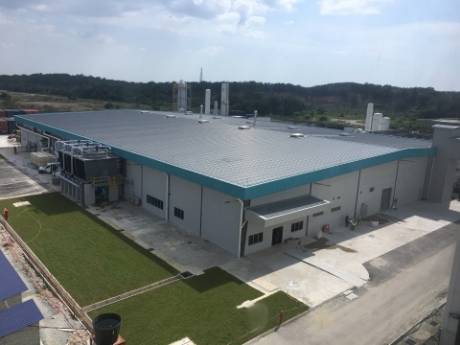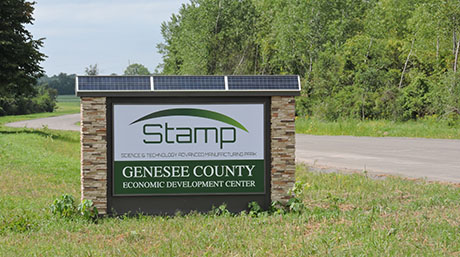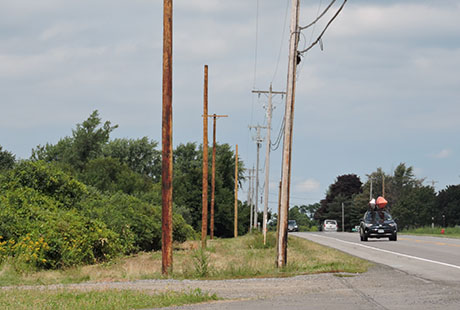Schumer pitches top brass at Samsung on shovel-ready STAMP site for new semiconductor plant
Press release:
U.S. Senate Majority Leader Charles E. Schumer yesterday (Jan. 27) followed up on his efforts to secure a provision in the FY2021 National Defense Authorization Act to boost American-based semiconductor manufacturing by reaching out directly to Samsung, which is interested in possibly locating their new plant in Genesee County.
He called Senior Vice President of Samsung Device Solutions Joe Herr and other top brass about the Genesee Science and Technology Advanced Manufacturing Park -- STAMP -- in Alabama and expressed his strong support for the project coming to Western New York.
Samsung is currently considering the STAMP campus, as well as several other locations in other states, for its semiconductor fabrication (“fab”) plant – with 1,900 jobs – that the company plans to open late next year. Samsung’s Device Solutions division includes Samsung’s Global Semiconductor Foundry business.
“This Samsung project is an exciting and a potential game changer for the region," Schumer said. "I made it clear to Samsung that I strongly support locating their planned 1,900 worker state-of-the-art semiconductor chip fab at the shovel-ready STAMP site in Genesee County. I know firsthand that STAMP is shovel-ready – and that, combined with Upstate New York’s robust semiconductor industry, make Genesee the perfect location for Samsung’s new chip fab.
World-class WNY Workforce
"Our world-class Western New York workforce combined with New York’s considerable experience in semiconductor manufacturing and R&D means STAMP is tailor-made to be the home for Samsung’s new facility. I stand ready to help Samsung harness all that the federal government has to offer to continue to lead the tech industry and position New York as a global hub of semiconductor manufacturing.
“When I stood at STAMP in August to announce my proposal to create the first-ever new federal semiconductor manufacturing and R&D incentives program, I said it could put sites like Western New York’s STAMP in contention for landing a new semiconductor manufacturing plant and the thousands of new jobs that come with it.
"This game-changer proposal passed into law last month and already companies like Samsung are considering STAMP for a 1,900 job chip fab plant, partly because of this new federal initiative. Now, I will work to secure this federal investment and offer my all-out support and advocacy in helping STAMP compete for this multi-billion-dollar plant.”
Schumer has long championed the Genesee site and toured STAMP in August, and knows firsthand how ideal the campus would be as home for Samsung’s new chip fab. Schumer explained to Samsung that he, alongside the Genesee County Economic Development Center (GCECC), New York State, and Western New York officials, worked for a decade to help ensure that it was shovel-ready for a semiconductor facility.
WNY Offers: Low Utility Costs, Transportation Networks, Supplies Access, Brain Power
“The STAMP campus, sitting on 1,250 acres of land between Buffalo and Rochester, New York’s second and third largest metros, respectively, with a 1.2 million person world-class workforce, is specifically designed for large-scale fabs and provides maximum flexibility in layout and infrastructure connections,” Schumer said.
"Additionally, the senator pointed out many cost and infrastructure advantages to the STAMP campus location, including low utility costs, access to existing transportation networks, access to New York state’s existing chip fab supply chain ecosystem, and 62 colleges, universities, and community colleges within a two-hour drive of the site including Cornell University, University at Buffalo, Rochester Institute of Technology, University of Rochester, Genesee Community College.
Schumer said Samsung is relying on his legislation to building new fabs like this one in the United States. In fact, Schumer pointed out, the United States has gone from producing 24 percent of the world’s semiconductors in 2000, to just 12 percent while China, by comparison, has gone from producing zero chips to 16 percent of the world’s supply because the United States is not matching the investments that other competing nations are making in order to land new job-creating semiconductor chip fabs.
The senator's first-ever legislation will reverse this imbalance and level the playing field for companies like Samsung to build new chip fabs in the United States. For the first-time Schumer’s legislation will provide federal incentives to semiconductor chip fabs to build in the United States.
U.S. Reliance on Foreign-made Microelectronics Could Pose 'Huge Risks'
Upon passage of his legislation last month in the FY2021 National Defense Authorization Act Schumer said his legislation is vital. He noted that even though the United States revolutionized the microelectronic industry and invented nearly all of the key technology used to this day, by 2030, non-U.S. competitors are projected to control 83 percent of the global semiconductor manufacturing supply while domestic production could be less than 10 percent, threatening U.S. reliance on foreign-made microelectronics, which could pose huge risks to U.S. national and economic security.
In a recent meeting with the Commerce Secretary nominee, Governor Gina Raimondo, Schumer raised the urgent need to fully fund and implement the new Commerce semiconductor manufacturing grant program he passed into law as part of last year’s defense authorization, pointing to this Samsung investment as an example for why these federal incentives are such a high priority. Federal incentives are critical to the United States successfully competing with other countries, including China, for new semiconductor manufacturing investment like the proposed Samsung facility.
Schumer, in addition to paving the way for future federal incentives for investment into domestic semiconductor manufacturing previously brought STAMP to the attention of the Department of Defense, urging the agency to work with the semiconductor industry to expand the domestic supply of chips and other microelectronics.
STAMP is Made Specifically for What Samsung Needs
STAMP is specifically designed for development of large-scale semiconductor manufacturing. The 1,250 acre mega site can accommodate large advanced manufacturing operations with its expansive space for several plants.
Schumer has also previously lobbied the Board of Directors of the Semiconductor Industry Association (SIA) to put STAMP on their map and pitched SIA’s 18 semiconductor industry CEOs to look to expand their operations in Upstate New York at sites like STAMP in Genesee County.
In 2017 Schumer helped secure Federal Energy Regulatory Commission (FERC) approval of Empire Pipeline Inc.’s revised and extended PILOT agreement with Genesee County, the proceeds of which were needed to finance new water infrastructure at STAMP.
In 2016 Schumer began assisting STAMP secure necessary U.S. Fish and Wildlife right-of-way permits to construct new infrastructure hook-ups to STAMP. In 2012, Schumer successfully advocated on behalf of STAMP by calling on the U.S. Army Corps of Engineers to provide necessary wetlands permit assurances so that STAMP's developers could proceed with developing the site.




